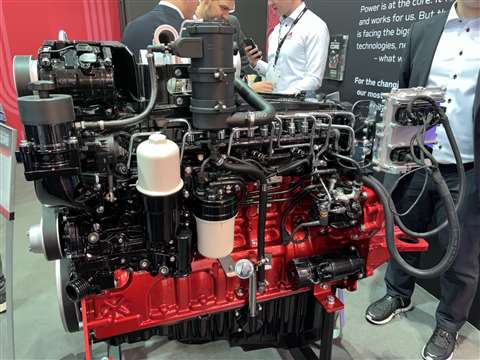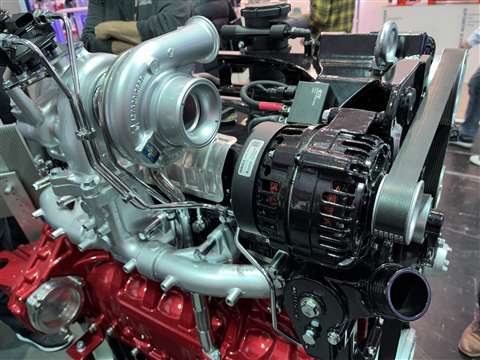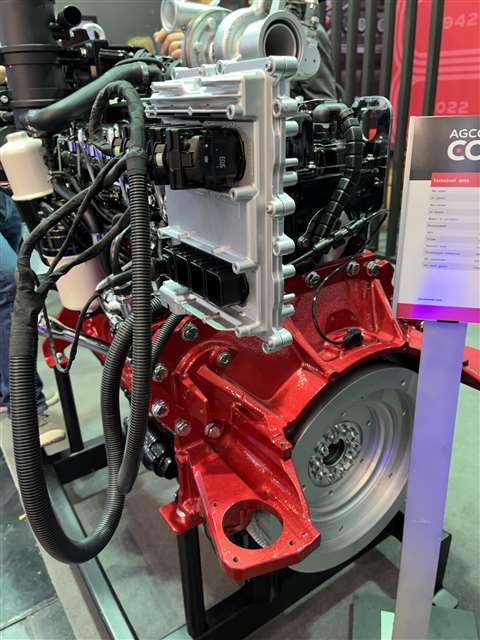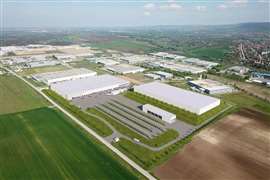AGCO’s new engine platform supports future fuels
31 October 2022
 The 223-kW CORE75 7.5-liter, six-cylinder diesel/HVO engine is designed to meet EU Stage V/Tier 4 Final using a DOC/DPF/SCR aftertreatment system. (Photo: Diesel Progress staff)
The 223-kW CORE75 7.5-liter, six-cylinder diesel/HVO engine is designed to meet EU Stage V/Tier 4 Final using a DOC/DPF/SCR aftertreatment system. (Photo: Diesel Progress staff)
The “baseline” for development of AGCO Power Inc.’s new engine platform was to better serve the needs of the future. This meant developing a platform capable of supporting fuels beyond those already served by the company’s current engine models.
Engines produced by AGCO are compatible with hydrotreated vegetable oil (HVO). However, the new engine platform was developed to take this a step further. “Alternative fuels and electrification [were] all taken into account when we started the design,” said Tapani Katila, AGCO account manager.
Low speed optimizes fuel efficiency
Product development included simulation and iteration of the design not only by the research and development team but by the company’s suppliers to ensure maximum performance from the engine. “This is why we have really met the highest level of efficiency and low fuel consumption,” said Katila.
 The engine has a bore x stroke of 110 mm x 132 mm and comes equipped with eWastegate turbocharger technology. (Photo: Diesel Progress staff)
The engine has a bore x stroke of 110 mm x 132 mm and comes equipped with eWastegate turbocharger technology. (Photo: Diesel Progress staff)
The first engine in the new series, the CORE75, was displayed to the public for the first time at Bauma 2022 in Munich, Germany. The 7.5-liter, six-cylinder model is a 223-kW diesel/HVO designed to meet EU Stage V/Tier 4 Final using a DOC/DPF/SCR aftertreatment system (EAT technology), with no EGR required. It has a bore x stroke of 110 mm x 132 mm and comes equipped with eWastegate turbocharger technology.
The CORE75 runs at lower speeds. “Where traditionally the engines have been running at 2100 or 2200 rpm, this is actually [running at] 1700 rpm. That reduces the noise and brings us the possibility to better optimize the engine to get really high efficiency,” Katila stated.
The CORE75 is designed to offer maximum torque (1450 Nm) at 1300 rpm rather than the more typical 1500 rpm. This low-speed concept enables enhanced fuel economy of 188 g/kWH.
 The CORE75 is designed to offer maximum torque (1450 Nm) at 1300 rpm, a low-speed concept that enables enhanced fuel economy of 188 g/kWH. (Photo: Diesel Progress staff)
The CORE75 is designed to offer maximum torque (1450 Nm) at 1300 rpm, a low-speed concept that enables enhanced fuel economy of 188 g/kWH. (Photo: Diesel Progress staff)
“The biggest benefit of this engine is the fuel efficiency. It’s below 190 g/kWH, [which] I think is a leading number in the industry,” said Katila. “If someone is comparing that to the cost of electrifying the engine, you can actually run this with clean HVO and with a low fuel [consumption] already today. That’s a big asset for any operator that they can have a fuel with low emissions, and at the same time, the engine has very high efficiency.”
Future fuel capable
Currently, the new engine can burn diesel plus is 100% compatible with HVO. “At the same time… we have developed it with alternative fuels in mind,” Katila said. “We are developing it for hydrogen use and for [fuels] like biomethane.” The CORE platform is capable of supporting future fuel developments based on the direction in which the market heads.
The CORE75 will begin production at the end of 2022, with its first application in the new Fendt Vario Gen7 tractor starting in 2023. “Later on, we will bring more tractor applications and also make it as an industrial engine,” said Katila.




